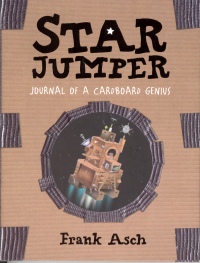| ________________
CM . . .
. Volume XII Number 18 . . . .May 12, 2006
excerpt:
The well-known children’s author Frank Asch, who has written such playful picture books as Popcorn, Mooncake, and I Can Roar Like a Lion, has just published a charming illustrated novel about a boy who can build anything out of cardboard. Alex, a self-proclaimed genius, is keeping a journal, or, as he calls it, a “historical document” of the building of his spaceship. Alex tells the reader that he wants to build a spaceship to leave Earth because he can no longer live with his pesky little brother Jonathan. Jonathan is always trying to get into Alex’s room and wants to play with all the wonderful inventions that Alex has built for his adventure, and Alex has tried everything to get away from his little brother. Throughout the novel, Asch has included small and quirky illustrations of Alex working on his spaceship and the blueprints of his other inventions that he has made to help his trip into space. While the illustrations are simplistic in nature and in no way as good as the images Asch created for his picture books, they are meant to be Alex’s illustrations and to add to the novel’s imagination. With Asch’s simple illustrations, the reader is able to visualize some of the peculiar gadgets, such as The Atom Slider, The Micro-Blaster, and The Duplicater, which Alex is building to escape Earth and his brother forever. Asch’s novel is full of imagination and creativity. He conjures up both the reality and the imagination of his main character, and he leaves it up to the reader to decide whether or not Alex’s inventions really work. Because of the creativity of the plot, readers are encouraged to use their own imaginations, something every good children’s novel should call for. In particular, because of all the mechanical details of Alex’s inventions, boys may be more interested in this novel than girls as it is loaded with information about how to build a real spaceship using cardboard boxes, duct tape and a few other household items. Asch’s language is simple and easy to read and would be attractive to reluctant readers. Recommended. Geneviève M.Y. Valleau is currently enrolled in the Master’s of Arts programme in Children’s Literature at the University of British Columbia in Vancouver, BC.
To comment
on this title or this review, send mail to cm@umanitoba.ca.
Copyright © the Manitoba Library Association. Reproduction for personal
use is permitted only if this copyright notice is maintained. Any
other reproduction is prohibited without permission.
NEXT REVIEW |
TABLE OF CONTENTS FOR THIS ISSUE
- May 12, 2006.
AUTHORS |
TITLES |
MEDIA REVIEWS |
PROFILES |
BACK ISSUES |
SEARCH |
CMARCHIVE |
HOME |
